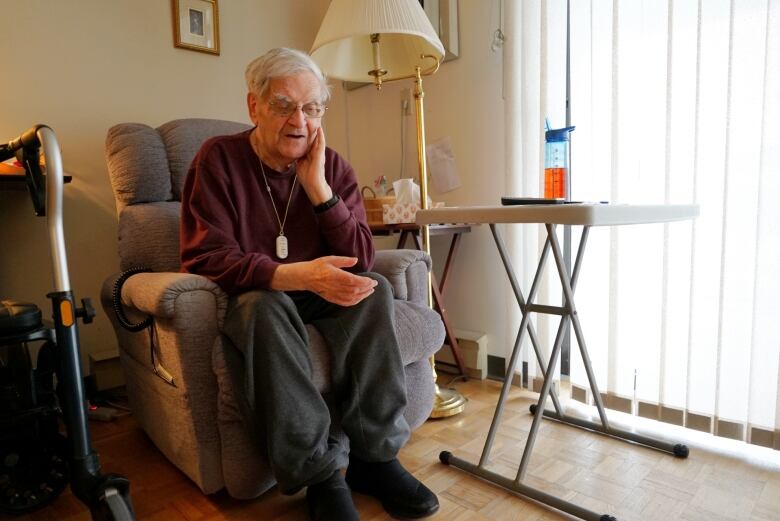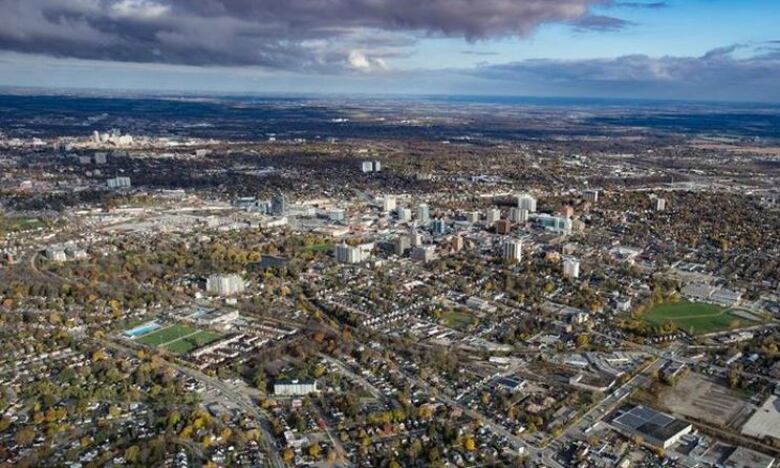Reflecting on amalgamation of Cambridge and what it could tell us about future of Waterloo region
Former MPP John Milloy says current 2-tier government doesn't benefit community
Erwin Nelson remembers theearly conversations to amalgamatethe towns ofHespeler, Galtand Preston, Ont.,50 years ago. He was there, after all.
The former reeve of Hespeler is now 91 years old and lives at St. Luke's Place, in Galt,a long-term care home and seniors community.
He held the top job in Hespeler before amalgamation took place in 1973. Helater served ascouncillor for Cambridge's Ward 14 and was even mayor of Cambridge from 1976 to1978, after Bob Kerr stepped down.
"Galt, Preston and Hespeler were three municipalities who co-existed beside each other, but itwas still separate municipalities geographically and competitively," Nelson told The Morning Edition's host Craig Norris during an interview in his home.
"We never got along with Galt, we never got along with Preston, but we had to exist because the Ontario government said, 'That's enough of this annexation,'" he said.
Expansion was moving north and farmers in the area were losing land as a result, Nelson recalls, adding that Cambridge's amalgamation was alsotied to the creation of the Region of Waterloo, which also turns 50 in 2023.
Bill Davis,premier of Ontario from 1971 to 1985, issued a directive, said Nelson:
"Davis said, 'You're going together. You're not going to be three municipalities when the region comes,'" Nelson said.

'We loved to play hockey against each other'
Though there was a rivalry between the three towns, Nelson said there was also aknitting together of the communityin that time. They loved to play hockey against each other for example, Nelson said.
"The penalty box was always full and Friday nights you couldn't get a seat in the Hespeler Arena for minor hockey," he said laughing.
But when it came to amalgamating the towns, community members and municipal leaders were on the same page:No one wanted it,Nelson said.
The amalgamation of Cambridge and the region was a relatively quick process too, according to Nelson, saying it was around 1970 when the County of Waterloo started to see the possibility ofa larger municipality.
He remembers working with the Ministry of Municipal Affairs around that time work throughthe process of amalgamation.
"Davis introduced the legislation and in January 1973 is when I believewe became the region ofWaterloo. And Waterloo got to keep its name," he said.

Talks about amalgamation, again
When reflecting on where he sees Cambridge in the next 50 years, Nelson believes the city will become part of an amalgamated Region of Waterloo.
"I won't see the day, but I can see this one city deal on the horizon," he said.
Conversations around the amalgamation of the region has been brought upby some local leaders in recent weeks.
John Milloy, the former Liberal MPPfor Kitchener Centre, toldThe Morning Editionit's important forthe community to be aware and talk about amalgamation,given the province's "top downapproach."
Eight governments and 59 elected officials ...it makes no sense- John Milloy, former Liberal MPP for Kitchener Centre
Last fall, the provincial government announced plans to appoint a facilitator who will asseswhat's working and what's not in the two-tier government structure.
"Municipal governments are creatures of the province and the newprovincial government is different from [our Liberal government], which basically said there is no interest in amalgamation unless the communities came forward and wanted it for themselves," Milloy said.
"This government is taking a different approach, a more top down approach and signaled it's willing to take a bit of aheavy hand in the way municipalities are governed."

Worth exploring a 'new form of government'
The Region of Waterloo is made up of three cities and four townships. The regional government has a chair and councillors representing each municipality.
Milloy saidit's worth exploring a "new form of government" that would be more streamlined.
"I think eight governments and 59 elected officials, I think many of us are starting to recognize how it makes no sense and that we should look at an amalgamation," he said.
Milloysaid the currenttwo-tiered government hurts the region's ability todraw new business investment, for instance.
During his time in office, Milloy said he saw that potential employers would rather do business with cities like London and Hamilton because they don't have to deal with multiplegovernments. Being one big city would also change the region's bargaining power with the federal and provincial governments.
"If we were one tier government, one big community, we would be the 10th largest, I believe,in the country and that would give whoever headed us up, the mayor or chair, some real clout in terms of knockingon the door of Queen's Park or knocking on the door on Parliament Hill," he said.
It's not clear if the provincially-appointed facilitator will consult with the public or talks will be between the province and municipal officials, Milloy said, but he would like to see public inputduring the process.
"Simply sitting down with our councillors, who are elected, who are there to represent us and not engaging the wider population, not having them think about options and thinking aboutstatus quo and what could be different, I think is a disservice to our community," he said.
A spokesperson for Ontario's Minister of Municipal Affairs and Housing told CBC K-W thefacilitators will be looking at the division of powers in rapidly-growing regions that also have two-tier municipal structures.
They said the province is considering expanding strong mayor powers "to municipalities that are shovel ready and committed to growth and cutting red tape" and the facilitators will "help determine the best way to extend these powers in two-tier municipalities," the spokesperson said in an email.
While the spokesperson didn't provide a timeline for when the facilitators will be named, two sources told CBC Kitchener-Waterloo they expect someone to appointed in the next month.
With files from CBC's Joe Pavia













_(720p).jpg)


 OFFICIAL HD MUSIC VIDEO.jpg)
.jpg)



























































































